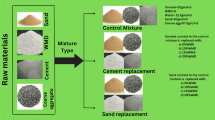Abstract
This paper aims to study the effect of different particle sizes of granulated blast-furnace slag (GBFS) as a partial or full natural fine aggregate substitution in concretes with different water/cement (w/c) ratios. Natural sand fine aggregate was substituted with GBFS at ratios ranging from 25% to 100%, by weight. Two different particle sizes of GBFS (0.16 and 0.5 mm) and w/c ratios (0.5 and 0.6) were used. Workability, mechanical strength and abrasion resistance at ages ranging from 7 to 180 days were measured. The morphology of selected concrete samples were examined by scanning electron microscopy (SEM). The results showed a negative effect of GBFS fine aggregate on the workability of concrete mixtures. The incorporation of GBFS as a fine aggregate in concretes may increase or decrease mechanical strength and abrasion resistance. This depending on its particle size as well as w/c ratio.
Similar content being viewed by others
References
Neville AM, Brooks JJ (1990) Concrete technology. Longman Group Limited, London
Rashad AM (2014) Recycled waste glass as fine aggregate replacement in cementitious materials based on Portland cement. Constr Build Mater 72:340–357
Rashad AM (2015) Recycled cathode ray tube and liquid crystal display glass as fine aggregate replacement in cementitious materials. Constr Build Mater 93:1236–1248
Rashad AM (2016) A brief review on blast-furnace slag and copper slag as fine aggregate in mortar and concrete based on Portland cement. Rev Adv Mater Sci 44:221–237
Alaa R (2016) Cementitious materials and agricultural wastes as natural fine aggregate replacement in conventional mortar and concrete. Journal of Building Engineering 5:119–141
Reilly JF (2019) “Menial commodity summaries 2019” Department of the Interior, US Geol Surv, 1–200, https://prd-wret.s3-us-west-2.amazonaws.com/assets/palladium/production/atoms/files/mcs2019_all.pdf. Accessed 2019.
Rashad AM (2018) An overview on rheology, mechanical properties and durability of high-volume slag used as a cement replacement in paste, mortar and concrete. Constr Build Mater 187:89–117
Seleem Hosam El_Dine H, Rashad Alaa M, Tarek E (2011) Effect of elevated temperature on physico-mechanical properties of blended cement concrete. Construction and Building Materials 25:1009–1017
Ismail ZZ, Al-Hashmi EA (2048-2053) Reuse of waste iron as a partial replacement of sand in concrete. Waste Manag 28:2008
Mosavinezhad SHG, Nabavi SE (2012) Effect of 30% ground granulated blast furnace, lead and zinc slags as sand replacement on the strength of concrete. KSCE J Civ Eng 16(6):989–993
Binici H, Durgun MY, Rizaoglu T, Koluçolak M (2012) Investigation of durability properties of concrete pipes incorporating blast furnace slag and ground basaltic pumice as fine aggregates. Scienctia Iranica A 19(3):366–372
Kumar PR, Bhusan MB (2017) Influence of incorporation of granulated blast furnace slag as replacement of fine aggregate on properties of concrete. J Clean Prod 165:468–476
Bekir TL, Turhan B (2010) Effect of non-ground-granulated blast-furnace slag as fine aggregate on shrinkage cracking of mortars. ACI Mater J 107-M61:545–553
Nataraja MC, Dileep KPG, Manu AS, Sanjay MC (2013) Use of granulated blast furnace slag as fine aggregate in cement mortar. Int J Struct Civil Eng Res 2(2):59–68
Isa Y, Ayten G (2007) Properties of concrete containing nonground ash and slag as fine aggregate 104-M44:39–40
İsa Y, Ömer Ö, Turhan B (2006) Use of granulated blast-furnace slag in concrete as fine aggregate. ACI Mater J 103-M23:203–208
İsa Y, Turhan B (2007) Usage of industrial by-products to produce plain concrete elements. Constr Build Mater 21:686–694
Turhan B, Isa Y (2017) Topcu Ilker Bekir and Gencel Osama, "effects of bottom ash and granulated blast furnace slag as fine aggregate on abrasion resistance of concrete". Sci Eng Compos Mater 24(2):261–269
Aboubakar FM, Yasuhiko S, Toshiki A, Kyoji N (2017) Experimental and numerical investigation of static and fatigue behavior of mortar with blast furnace slag sand as fine aggregates in air and water. Constr Build Mater 142:429–443
Rashad AM (2013) A preliminary study on the effect of fine aggregate replacement with metakaolin on strength and abrasion resistance of concrete. Constr Build Mater 44:487–495
Ali N, Shadi R (2011) Abrasion resistance of concrete containing SiO2 and Al2O3 nanoparticles in different curing media. Energy Build 43:2939–2946
Grdic ZJ, Curcic GA, Toplicic RNS, Despotovic Iva M (2012) Abrasion resistance of concrete micro-reinforced with polypropylene fibers. Construction and Building Materials 27:305–312
Gurpreet S, Rafat S (2012) Abrasion resistance and strength properties of concrete containing waste foundry sand (WFS). Constr Build Mater 28:421–426
Hui L, Mao-hua Z, Jin-ping O (2006) Abrasion resistance of concrete containing nano-particles for pavement. Wear 260:1262–1266
Tsong Y, Tsao-Hua H, Yu-Wen L, Shin-Ho C (2007) Influence of class F fly ash on the abrasion-erosion resistance of high-strength concrete. Constr Build Mater 21:458–463
Şükrü Y, Ahmed Ç (2011) Abrasion resistance of cement mortar with different pozzolanic compositions and matrices. J Mater Civ Eng 23(2):138–145
Shadi R, Ali N (2011) Compressive strength and abrasion resistance of concrete containing SiO2 and CuO nanoparticles in different curing media. Sci China Technol Sci 54(9):2349–2357
Elżbieta H (2005) Abrasion resistance of high-strength concrete in hydraulic structures. Wear 259:62–69
Author information
Authors and Affiliations
Corresponding author
Additional information
Publisher’s Note
Springer Nature remains neutral with regard to jurisdictional claims in published maps and institutional affiliations.
Rights and permissions
About this article
Cite this article
Rashad, A.M., Sadek, D.M. Influence of Different Particle Sizes of Blast-Furnace Slag as a Fine Aggregate on Mechanical Strength and Abrasion Resistance of Concrete. Silicon 12, 2365–2373 (2020). https://doi.org/10.1007/s12633-019-00332-0
Received:
Accepted:
Published:
Issue Date:
DOI: https://doi.org/10.1007/s12633-019-00332-0




